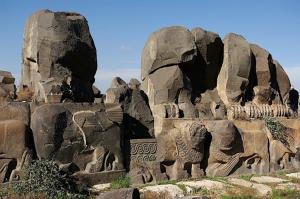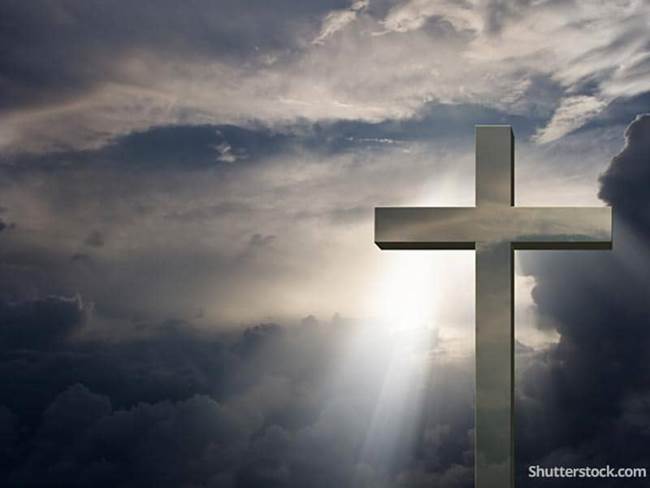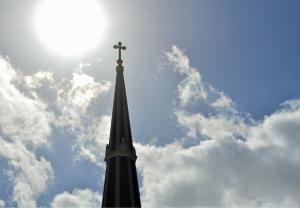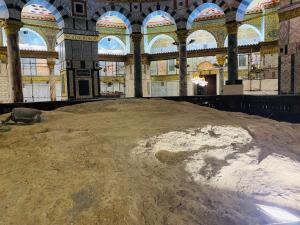

Damage caused by ISIS has been replaced by damage caused by airstrikes
For the first time in five years, the destruction of religious sites of all faiths by ISIS largely came to an end in 2018. One of the last major religious sites reported destroyed by ISIS was the Sufi Shrine in Kirkuk. Unfortunately, the carnage of war goes on. Earlier in the year, allied military aircraft carried out numerous attacks in northern Syria and Iraq that have reduced many of the region’s religious sites to rubble. Ancient Assyrian churches and Yazidi temples have been particularly hard-hit. The most tragic loss in the fighting this year was the Temple of Ain Dara in Northern Syria. More than half of this 3000 year old temple, a contemporary of Solomon’s Temple in Jerusalem, now lies in ruins.
Further south, airstrikes in the ongoing conflict in Yemen seem to be deliberately targeting ancient religious sites despite the protests of UNESCO. Many of these have been destroyed over the last few years, most recently the fourth century BC Temple of Nakrah. In a related tragedy, an arms cache in Baghdad accidentally exploded, destroying an historic Sadr City Mosque. It is unclear if the cache was being kept inside the mosque.
Sectarian violence and vandalism target shrines in Africa and Asia
In general, destruction of sacred sites of one religious group by another religious group appears to have decreased in 2018, especially in Africa. However, even Africa was not immune; despite significant improvements in both Nigeria and Niger, bombings of mosques were reported in both countries. Both Christian and Muslim religious sites have been targeted by extremist groups in Libya. One of the most prominent sites destroyed in Africa this year was not in the Sahara region at all, but the Njelele Shrine near the town of Matobo in Zimbabwe, which was bombed by an as yet unidentified attacker.
The Indian Subcontinent witnessed significant religious unrest this year. A Sunni mob destroyed the historic Ahmadi Mosquein Sialkot, Pakistan, while bombings of mosques and churches were reported in Afghanistan and Nepal, respectively. In India, mob attacks against churches took place in the east-central region, notably Odisha. The Sangameshwar Church, the only church in a small village near Hyderabad, was completely destroyed.
Demolitions on the rise from Massachusetts to Maharastra
Deliberate demolitions of sacred places around the world were up last year. Many of these were due to the inability or unwillingness of religious groups to maintain aging structures. New England in the United States noted a large number of such demolitions, especially of Catholic structures in Massachusetts. These include (or will soon include) the Mater Dolorosa Church in Holyoke, the Notre Dame Church in Worcester, and the Immaculate Conception Church in Fall River.
In other places, demolitions have taken place in the name of “progress.” The Indian province of Maharashtra has witnessed a number of such losses lately, including the Durga Devi Temple in Nagpur and the Bawkhaleshwar Temple in Navi Mumbai. Malaysia also saw the destruction of a number of Hindu shrines for similar reasons. The popular Bridge Temple in Port Klang may be among these in the near future.
China experienced the loss of many churches and mosques in 2018. Prominent demolitions have included two Catholic Marian shrines, the Church of Our Lady of the Seven Sorrows and the Church of Our Lady of Bliss. Also demolished was theGolden Lampstand Church in Shaanxi province, one of the largest churches in China. In neighboring Myanmar, the deliberate destruction of churches was widespread.
In a few cases, religious sites that were previously damaged faced (or will soon face) the wrecking ball. Among these were the United Orthodox Synagogue in Houston, Texas, damaged by flooding from Hurricane Harvey; the Cathedral of the Blessed Sacrament in Christchurch, New Zealand, damaged by earthquake; and St. Mary’s cathedral in Marawi, Philippines, damaged by sectarian fighting.
Other losses in 2018 include the the Kilifi Mosque in Kilifi, Kenya, torn down due to a land dispute; and the Breslov Synagogue in Elad, Israel, which had been constructed illegally. And, in what may have been the most shameful demolition of the entire year, the St. Lambertus Cathedral was razed, along with many of the historic buildings of Immerath, Germany, in order to make way for a coal mining operation.
Historic shrines lost to storms in the Americas, earthquakes in the Far East
Once again, catastrophic storms ravaged the American South this year, with Hurricane Michael dominating the headlines this October. Michael, and other major weather events in 2018, laid waste to churches from the Caribbean islands to Virginia. Notable losses include St. Dominic Catholic Church in Panama City, Florida; the West Point Baptist Church in Jacksonville, Alabama; and the Central Baptist Church in Appomattox, Virginia. In Italy, the city of Venice experienced some of its worst storm surges ever, leaving many historic churches underwater. The Basilica of St. Mark, where the Biblical Evangelist is buried, received minor damage from flooding that lasted more than half a day.
In general, earthquakes and their attendant tsunamis did far less damage this year than usual. There were a few major exceptions, however. A series of earthquakes in Japan left many shrines there damaged to varying degrees, including the Myotokuji Temple in Osaka. The worst destruction was seen in Indonesia, especially around the island of Sulawesi. Sulawesi was hit by a string of major earthquakes and tsunamis that leveled entire regions. Hundreds of churches and mosques were completely laid waste. The city of Palu, ground zero of the devastation, saw the loss of many religious buildings. The foundation of its famous Floating Mosque was compromised, leaving the mosque partially submerged and with an uncertain future.
Fires take their usual heavy toll on religious sites around the world
Every year, fires, both accidental and deliberate, devastate religious sites around the world, and 2018 was no exception. Major arson attacks appear to have decreased worldwide this year, but sadly there were still many. Among these was the badly damaged Koca Sinan Camii Mosque in Berlin, Germany; the historic Bethel Community Church in Newport, Wales, which was spread from a nearby fire started by arson; and the Islamic Cultural Center of Hassleholm, Sweden, where arson is suspected.
Accidental fires hit religious sites in the United States especially hard this year. Losses include the House of Israel Temple of Faith, a Black Hebrew Temple, on the south side of Chicago; the Trinity Evangelical Lutheran Church in Milwaukee, Wisconsin; and the Shriner’s Oman Temple in Flint, Michigan. The First Baptist Church in Wakefield, Massachusetts was completely destroyed by fire, though a painting of Jesus that had been hanging in the church was spared, and the Emanuel Episcopal Churchin Brooklyn, New York had the misfortune of burning down for the second time in less than a dozen years. The toll taken on religious sites by the California wildfires has not even been tallied yet.
The Watford Hindu Temple in Watford, England, a gift of musician George Harrison, narrowly escaped destruction when a neighboring barn on the property burned down. The Beit Midrash Morasha Synagogue in Cape Town, South Africa, was not so lucky. It was completely destroyed by fire, along with millions of dollars in historic Torah scrolls. Probably the most devastating fire, in terms of historic importance, was that which struck the Jokhang Temple in Lhasa, Tibet. The Jokhang Temple, one of the most sacred Buddhist temples in the world, was not completely destroyed, though the extent of the damage is not fully known.
In Memoriam
The Complete Pilgrim would like to dedicate this year’s article to the many victims of religious violence around the world in 2018. In particular, it is dedicated to the eleven congregants killed at the Tree of Life Synagogue in Pittsburgh, Pennsylvania, close to where I attended college; and to the 42 worshippers killed at the Cathedral of the Sacred Heart in Alinandao in the Central African Republic, across the border from where I served as a Peace Corps volunteer in Chad.
Howard Kramer is the creator and author of The Complete Pilgrim. He first took an interest in religious sites in his early twenties when traveling through Italy after college. In the two decades since he has traveled to more than two dozen countries and almost every state, visiting and photographing hundreds of the world’s greatest churches, synagogues and other places of religious interest. Howard has been writing about religious sites for the better part of the last decade, and The Complete Pilgrim is the culmination of years of his work and passion.
Images from the Syrian Ministry of Culture, licensed under a Creative Commons Attribution-ShareAlike 4.0 International License.













